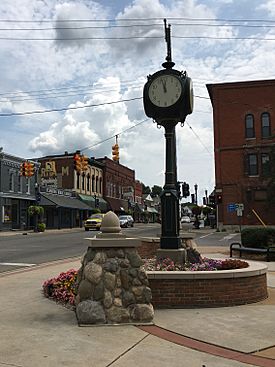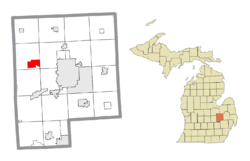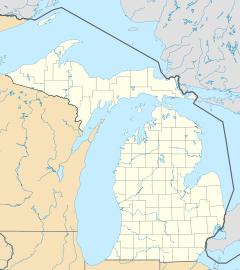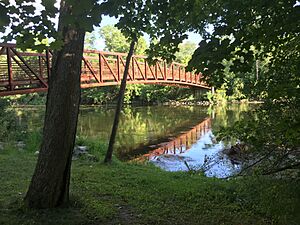Flushing, Michigan facts for kids
Quick facts for kids
Flushing, Michigan
|
|
|---|---|
| City of Flushing | |

Downtown Flushing looking east along Main Street from the Flint River
|
|

Location within Genesee County
|
|
| Country | United States |
| State | Michigan |
| County | Genesee |
| Platted | 1840 |
| Incorporated | 1877 (village) 1964 (city) |
| Government | |
| • Type | Council–manager |
| Area | |
| • Total | 3.73 sq mi (9.67 km2) |
| • Land | 3.61 sq mi (9.35 km2) |
| • Water | 0.12 sq mi (0.31 km2) 4.49% |
| Elevation | 699 ft (213 m) |
| Population
(2020)
|
|
| • Total | 8,411 |
| • Density | 2,329.27/sq mi (899.26/km2) |
| Time zone | UTC-5 (EST) |
| • Summer (DST) | UTC-4 (EDT) |
| ZIP code(s) |
48433
|
| Area code(s) | 810 |
| FIPS code | 26-29200 |
| GNIS feature ID | 0626199 |
Flushing is a city in Genesee County, Michigan, United States. In 2020, about 8,411 people lived there. Flushing is like a smaller town, or suburb, next to the bigger city of Flint. It's located inside Flushing Charter Township, but it has its own separate government.
Flushing started as a town with mills in the mid-1830s. It was built along the Flint River, which is the biggest river in the county. The river's strong current was perfect for powering mills. This "water power" was very important for choosing where to build towns back in the 1800s. Besides the river, the land around Flushing was also great for farming.
The town was first going to be called Dover. But then people found out there was already a Dover in another county. So, Charles Seymour Sr., who used to live in Flushing, Long Island, decided to name the new Michigan town after his old home.
Contents
History of Flushing
The first people known to live in the Flushing area were the Sauk Native Americans. There's evidence that a battle, sometimes called the second battle of Skull Island, happened here. Ancient burial mounds were found along the Flint River near what is now the Flushing Valley Golf Club. About 20 mounds were seen around 1833 or 1834.
Early Settlement and Mills
In 1835, Charles Seymour Sr. from New York bought land in the Flushing area. In 1836, he teamed up with Horace Jerome, who had bought rights to use the river's water power. Charles provided timber, and Horace built a mill. The saw mill started working in the summer of 1837. Horace Jerome left Flushing after his bank, the Flint Rapids Bank, failed in 1838.
Charles Seymour Sr. officially mapped out the village of Flushing on December 3, 1840. He named it after the township it was in. In 1843, Charles sold his share to his brother, James Seymour. James then made another map of the town in 1847.
In 1850, a flat-bottomed boat began carrying goods and people between Flint and Flushing, making travel easier.
Growing as a Village
- 1868: A group called the Masons, Flushing Lodge No. 223 F. & A. M., was officially started.
- 1873: Women in the village formed the Flushing Ladies' Association.
- 1874: A private fire department, the Wolverine Fire Company, was created. People paid to join it. It had 35 members and its first chief was Arza N. Niles. They bought a special small fire engine.
- 1877: Flushing officially became a village on March 21, 1877. The first election was held on May 8, 1877, and Oscar F. Clarke became the first village president. After this, the private fire company gave its equipment to the new village government. In 1878, the fire engine helped stop a big fire in the business area from spreading beyond a saloon and a hotel.
Newspapers and Railroads
The first local newspaper in Flushing was called The Flushing Patrol. It started on October 18, 1878, by D. C. Ashmun. In 1880, a year's subscription cost $1.50. The paper promised to focus on "The Interests of Flushing and Vicinity." On June 15, 1882, Ashmun sold the paper to Albert E. Ransom, who changed its name to The Flushing Observer.
The railroad came to Flushing in 1888. John Ashley led the project for the Toledo and Ann Arbor Railroad. This train line connected Flushing to Durand and Saginaw. Construction reached Flushing in July 1888. The first passenger train arrived from Saginaw on December 17, 1888. A ticket from Flushing to Saginaw cost 80 cents. The train crossed the Flint River for the first time on February 7, 1889. Today, the train line is owned by Huron and Eastern Railway. The old train station from 1888 has been restored and is now the Flushing Area Museum and Cultural Center.
Modern Utilities and Changes
- 1895: On March 25, people voted to approve a $20,000 bond to build a water system and an electric power plant. Water pipes were installed by November 1, 1895. Electricity was ready by November 15, 1895, including streetlights on Main Street. By January 1897, the village had 1600 light bulbs.
- 1918: The Hart Flour Mill burned down on March 19, 1918. It was the third mill on that spot and the third to burn. This mill used to provide electricity for the village. After it burned, Flushing was without power for 14 months until a new power plant was built.
- 1920: Main Street was paved.
- 1922: The current bridge on Main Street over the Flint River was finished in May 1922. It's a concrete arch bridge built by L. Smith, H. A. and M. C. Nichols. The bridge was updated in 1998 with new walkways and guardrails. The first wooden bridge on this site was built in 1839.
- 1956: Tucker Memorial Pool was opened on July 1, 1956. The money for the pool came from Max Dealton Tucker, who was born in Flushing and left money for the city in his will.
- 1965: A book called The Situation in Flushing was published by Edmund G. Love. He was born in Flushing and moved to Flint when he was 12. The book tells stories about his childhood in the early 1900s.
- 1975: The AT&T building was completed. It sits where James Seymour's home used to be. His home was built in the 1850s and torn down before the building was constructed.
- 2017: On November 27, 2017, Flushing and other nearby towns started getting water from the Karegnondi Water Authority pipeline. This water is treated by the Genesee County Water and Waste Division.
- 2020: Some city council members resigned due to new jobs or disagreements. A special election was held on August 4, 2020, to fill these open spots.
Education in Flushing
Students in Flushing attend schools run by Flushing Community Schools. Since 1954, Flushing has also had Saint Robert Catholic School, which teaches students from pre-kindergarten up to 8th grade.
Geography of Flushing
The area around Flushing is mostly shaped by the Flint River Valley. The Flint River flows north along the south and west parts of the city. It then continues north through Flushing Township. The river valley has rich, sandy soil that is great for plants to grow. Because of this, the valley has many thick forests with different kinds of trees. These areas provide beautiful natural settings.
The city covers about 3.79 square miles (9.67 square kilometers). Most of this area, about 3.62 square miles (9.35 square kilometers), is land. The rest, about 0.17 square miles (0.31 square kilometers), is water.
Historic Neighborhoods
The Main Street Historic District is a special area with old buildings. It includes buildings on Main Street and the Flushing Depot. These properties are listed on the National Register of Historic Places because they are important to history. There are 82 buildings in this district. They include commercial buildings built between 1850 and 1918, showing styles like Italianate. There are also homes built from 1850 to 1932, showing styles like Greek Revival, Italianate, Queen Anne, and Colonial Revival.
Environment and Resources
Flushing has a system to clean its wastewater. It uses two main methods: an activated sludge system (from 1972) and a batch reactor system (added in 1988). Dirty water is split between these two systems. After cleaning, the water is treated with UV light to kill germs before it goes into the Flint River. The cleaning plant is located on Industrial Drive, next to the Riverview Trail. The plant is currently getting a big upgrade, which started in 2022 and should finish in July 2023. The last upgrade was in 1986.
Pollution in the Flint River used to be a problem. But it has gotten much better since the 1950s and 1960s, thanks to laws like the Clean Water Act. Now, the river is a popular place for fishing, canoeing, and kayaking.
The City of Flushing gets its drinking water from Lake Huron. This water is pumped by the Karegnondi Water Authority and delivered by Genesee County. Before November 2017, the water came from a different source.
Electricity and natural gas in Flushing are provided by Consumers Energy.
Parks and Recreation
- Flushing Riverview Trail is a city trail along the Flint River. It connects to Flushing County Park.
City Parks in Flushing
- Riverview Park is a 7.4-acre park located along the Flint River. It's between the Main Street bridge and the DPW building.
- Mutton (Bonnie View) Park is a 3.5-acre park. It's located at the corner of Coutant Street and Chestnut Street.
- Waterworks Park is a 4-acre park off of Sunnyside Drive.
- Eastview Veterans' Memorial Park is a 14.4-acre park. It's located off of Coutant Street near Elms Road.
- River Road Park is a 4.6-acre park. It's located off of River Road near Morrish Road.
- Cornwell Park is a small, 0.2-acre park downtown. It's on the southwest corner of Main Street and Cherry Street. This park was created in 1961. A local businessman, Edgar L. Cornwell, set up a fund to turn the land into a park.
Events in Flushing
Flushing hosts several fun events throughout the year:
- Cruise Nights: On the third Saturday of each month from April to September. Cars gather near Riverview Park.
- Summer Festival: Held in June. It starts with a parade and lasts five days. There's a carnival in Riverview Park, live music, food, and other activities.
- Art in the Park: Also in June. Artists sell their work at Riverview Park.
- Concerts in the Park: On Wednesday evenings from June to August at Riverview Park.
- Movies in the Park: On Saturday evenings from June to August at Riverview Park.
- Harvest Festival: Held in September in downtown Flushing.
- Candle Walk: Held in December in downtown Flushing.
Population and People
| Historical population | |||
|---|---|---|---|
| Census | Pop. | %± | |
| 1860 | 406 | — | |
| 1870 | 687 | 69.2% | |
| 1880 | 690 | 0.4% | |
| 1890 | 965 | 39.9% | |
| 1900 | 900 | −6.7% | |
| 1910 | 938 | 4.2% | |
| 1920 | 1,169 | 24.6% | |
| 1930 | 1,723 | 47.4% | |
| 1940 | 1,806 | 4.8% | |
| 1950 | 2,226 | 23.3% | |
| 1960 | 3,761 | 69.0% | |
| 1970 | 7,190 | 91.2% | |
| 1980 | 8,624 | 19.9% | |
| 1990 | 8,542 | −1.0% | |
| 2000 | 8,348 | −2.3% | |
| 2010 | 8,389 | 0.5% | |
| 2020 | 8,411 | 0.3% | |
| U.S. Decennial Census | |||
Flushing Population in 2020
In 2020, the census counted 8,411 people living in Flushing. There were 3,338 households.
- Most residents (95.7%) were White.
- About 1.4% were African American.
- About 0.8% were Native American.
- About 0.1% were Asian.
- About 0.3% were from other backgrounds.
- About 2.0% were from two or more backgrounds.
- About 3.2% of the population was Hispanic or Latino.
On average, there were 2.31 people per household. About 22.8% of residents were under 18 years old. About 24.6% were 65 years or older. The population was 44.3% male and 54.7% female.
Flushing Population in 2010
In 2010, the census counted 8,389 people, 3,574 households, and 2,307 families.
- The racial makeup was 94.8% White, 2.4% African American, 0.4% Native American, 0.4% Asian, 0.3% from other races, and 1.6% from two or more races.
- Hispanic or Latino people made up 2.2% of the population.
About 28.0% of households had children under 18. About 48.3% were married couples. The average household size was 2.30 people, and the average family size was 2.90 people.
The average age in the city was 45.1 years. About 21.7% of residents were under 18. About 21.7% were 65 or older. The population was 46.1% male and 53.9% female.
Famous People from Flushing
- Shawn Cronin (born 1963): A retired professional ice hockey player. He played as a defenseman in the National Hockey League (NHL) for teams like the Washington Capitals and Philadelphia Flyers.
- Ralph M. Freeman (1902–1990): A United States district judge.
- John J. Gleason (born 1954): A Democratic politician who used to be the Clerk/Register of Deeds for Genesee County, Michigan.
- Matthew Rettenmund (born 1968): An author, known for his novel Boy Culture.
- Amanda Somerville (born 1979): A singer-songwriter and vocal coach.
- Edmund G. Love (1912–1990): An author, known for his book Subways Are for Sleeping.
- Tom Smallwood (born 1977): A professional ten-pin bowler.
Images for kids
See also
 In Spanish: Flushing (Míchigan) para niños
In Spanish: Flushing (Míchigan) para niños






